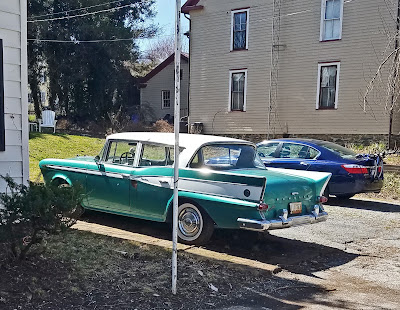Friday, March 26, 2021 (continued)
 |
John Brown's Fort/Armory Engine House (1848) was dismantled
in 1891 and displayed at the World's Columbian Exposition in
Chicago, then abandoned; in 1894 there was a campaign to return
the building to Harpers Ferry where it was rebuilt three miles
outside town; in 1909 Storer College had the building moved
onto its campus; finally in 1968 it was moved back to the
Lower Town by the National Park Service |
I will not relate the history of John Brown's Raid in this post.
 |
| John Brown's Fort (7/29/1999) |
Views from The Point in Harpers Ferry:
 |
View south toward the Shenandoah River with
stone piers of an 1882 bridge that was destroyed in a 1936 flood |
 |
| View farther upriver on the Shenandoah (7/29/1999) |
 |
| Panoramic view east toward the Potomac River and bridges |
*15 rifles (modified by Lewis)
24 pipe tomahawks
36 pipe tomahawks for “Indian Presents”
24 large knives for “Indian Presents”
15 powder horns and pouches
15 pairs of bullet molds
15 wipers or gun worms
15 ball screws
15 gun slings
extra parts of locks and tools for repairing arms
40 fish giggs (multi pointed-fish spears) for “Indian Presents”
collapsible iron boat frame
1 small grindstone*
 |
Replica collapsible iron boat frame designed by
Meriwether Lewis and Thomas Jefferson to make it easier to
portage around Great Falls of the Missouri River; work
on this boat frame turned a one-week stay into one month for Lewis
|
 |
Remains of one of several tailraces emptying into
the Potomac River; water power was used to run
the machines of the armory (KSS) |
The Harpers Ferry Armory was destroyed during the Civil War, and most of the property was sold. Interesting to note, a Virginia militia attacked the armory on 4/18/1861, dismantled the machinery, which ended up in Richmond, VA and Fayetteville, NC. Many of the Harpers Ferry armory workers followed the machinery to manufacture weapons for the Confederacy.
After lunch, we headed uphill from the Lower Town of Harpers Ferry.
 |
| Forsythia sp in full bloom |
 |
| Harper slate gateway |
 |
Hilltop House Hotel (founded 1888 by Thomas Lovett,
an African-American, rebuilt after fires in 1912 and 1919)
hosted notables such as Mark Twain, Alexander Graham Bell,
W E B DuBois, Woodrow Wilson, and Bill Clinton |
The hotel closed in 2008, due to deterioration of the foundation making it structurally unsafe. A hotel development company that purchased the property in 2007 and the town leaders have not been able to agree on the details of a project to build an upper-echelon hotel in the 1912 design of the original Hilltop House. After over a decade?!
 |
The Hilltop House property includes five Armory Dwellings
(1827-1837, as worker housing) on Magazine Hill |
 |
| Charmandoah (an "accommodation") |
 |
We took the steep Potomac Heritage
National Scenic Trail back down the ridge |
 |
Ruins of the Shenandoah Pulp Mill (1887-1888) that had
ten turbines over five sluiceways, closed in 1935 and is
the last remnant of water-powered industry in Harpers Ferry |
*On 4/18/1803, Meriwether Lewis departed Harpers Ferry.*
Next: Lewis & Clark Trip 1 C.







































































